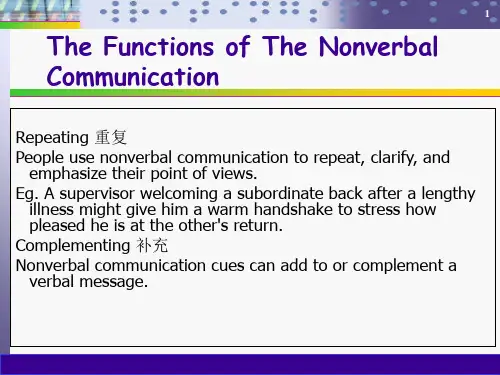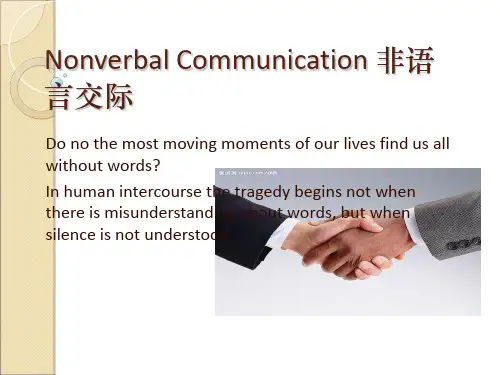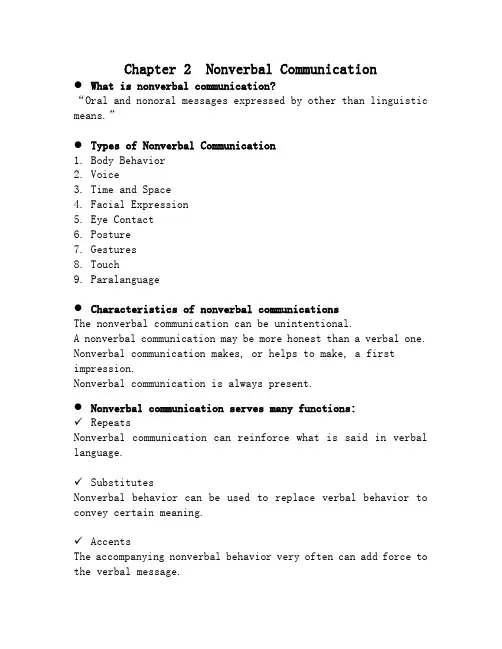Lecture 2Non-verbal Communication
- 格式:ppt
- 大小:864.00 KB
- 文档页数:33

《Non-verbal Communication》学历案《Nonverbal Communication》学历案在我们的日常生活和人际交往中,交流并不仅仅依赖于语言。
非语言交流(Nonverbal Communication)同样发挥着至关重要的作用,甚至在某些情况下,其影响力超过了语言本身。
非语言交流涵盖了多种形式,包括肢体语言、面部表情、眼神交流、姿势、手势、触摸、空间利用以及副语言等。
肢体语言,比如我们走路的姿态、站立或坐立时的姿势,都能传递出关于我们的情绪状态和态度的信息。
一个自信的人可能会昂首挺胸,步伐坚定;而一个沮丧或紧张的人可能会弯腰驼背,脚步拖沓。
面部表情是我们表达情感最直接和生动的方式之一。
微笑表示喜悦和友好,皱眉可能表示困惑或不满,瞪大的眼睛可能显示惊讶或恐惧。
眼睛被称为“心灵的窗户”,眼神交流能够传达出丰富的信息。
坚定而直接的眼神接触通常表示真诚和专注;而回避眼神可能暗示心虚、不自信或者不感兴趣。
手势在交流中也具有丰富的含义。
例如,挥手表示打招呼或告别,指向某个方向表示引导,竖起大拇指表示称赞等。
不同的文化中,手势可能有不同的含义,因此在跨文化交流中需要特别注意。
触摸也是一种非语言交流的方式,不过其含义和接受程度在不同的文化和情境中差异较大。
在某些文化中,拥抱和亲吻是常见的表示亲密和友好的方式;而在另一些文化中,这样的触摸可能被视为过于亲密或不适当。
空间利用也能反映出人与人之间的关系和交流的意图。
例如,在与亲密的朋友交流时,我们可能会站得比较近;而在与陌生人交流时,通常会保持一定的距离。
副语言包括声音的语调、语速、音量和停顿等。
同样的一句话,用不同的语调、语速说出来,传达的意思可能完全不同。
比如,快速而大声地说话可能表示激动或愤怒;缓慢而轻柔的语调可能表示安慰或亲密。
非语言交流在很多方面都具有独特的优势。
首先,它往往比语言更难以伪装。
尽管人们可以控制自己说的话,但非语言信号通常是下意识的反应,更能真实地反映内心的感受和想法。



《Non-verbal Communication》讲义《Nonverbal Communication》讲义在我们的日常生活和人际交往中,沟通是至关重要的。
而大多数人往往会将注意力集中在语言交流上,却忽略了另一种同样强大且具有影响力的沟通方式——非言语沟通(Nonverbal Communication)。
非言语沟通涵盖了各种形式,包括肢体语言、面部表情、眼神交流、姿势、手势、触摸,甚至包括个人的空间利用和服饰打扮等。
肢体语言是我们传递信息的重要手段之一。
例如,一个自信的人通常会挺直腰背,走路步伐坚定;而一个沮丧或缺乏自信的人可能会弯腰驼背,脚步拖沓。
当我们与他人交流时,如果对方不停地交叉双腿或者摆弄手指,这可能暗示着他们的紧张或者不耐烦。
再比如,双臂交叉抱在胸前,有时可能表示防御或拒绝的态度。
面部表情能够传达丰富而细微的情感。
一个真诚的微笑可以瞬间拉近人与人之间的距离,让人感到温暖和受欢迎。
皱起的眉头则可能表示困惑、担忧或不满。
眼睛是心灵的窗户,眼神交流在沟通中起着关键作用。
坚定而直接的眼神通常被视为诚实和自信的表现;而回避眼神接触可能暗示着心虚、不自在或者缺乏兴趣。
姿势也能传递出大量的信息。
一个开放、放松的姿势,比如身体前倾、双手自然摆放,显示出对交流的积极参与和接纳。
相反,蜷缩起来的姿势可能表示退缩和不愿意参与。
手势可以强化我们的言语表达。
在描述某个大小时,用手比划可以让对方更直观地理解。
但需要注意的是,不同的文化中,某些手势可能具有完全不同的含义。
比如,在某些国家,竖起大拇指表示赞赏;而在另一些国家,可能是一种不礼貌的手势。
触摸是一种非常亲密和有力的非言语沟通方式。
轻轻的拍肩可以表示安慰和鼓励;握手的力度和方式也能传达出不同的情感和态度。
然而,触摸的方式和程度必须根据关系的亲疏和文化背景来把握,否则可能会引起不适或误解。
个人的空间利用也在非言语沟通中扮演着角色。
每个人都有自己的“个人空间泡泡”,当他人侵入这个空间时,我们可能会感到不舒服或有压力。





Chapter 2 Nonverbal Communication●What is nonverbal communication?“Oral and nonoral messages expressed by other than linguistic means.”●Types of Nonverbal Communication1. Body Behavior2. Voice3. Time and Space4. Facial Expression5. Eye Contact6. Posture7. Gestures8. Touch9. Paralanguage●Characteristics of nonverbal communicationsThe nonverbal communication can be unintentional.A nonverbal communication may be more honest than a verbal one. Nonverbal communication makes, or helps to make, a first impression.Nonverbal communication is always present.●Nonverbal communication serves many functions:✓RepeatsNonverbal communication can reinforce what is said in verbal language.✓SubstitutesNonverbal behavior can be used to replace verbal behavior to convey certain meaning.✓AccentsThe accompanying nonverbal behavior very often can add force to the verbal message.✓RegulatesNonverbal communication very often functions to regulate the flow of the verbal interaction.✓ContradictsNonverbal behavior often betrays the speaker by sending contradictory messages to the verbal codes.●Nonverbal Communication Ithe importance of “first impression”Before someone processes our verbal messages,She has taken in our appearance,Registered our enthusiasm and sinceretyNoted our tone of voice and processed all into nonverbal message.●Nonverbal Communication II•If this message reinforce the content of verbal one, it means we send a powerful message.•If the two messages do not match, they may cancel each other and that means no messages delivered.•Nonverbal communication part of this training is for learning how to create a powerfull nonverbal message that will support your verbal content.●Projecting a Powerful Image IHow would you like to sound?How would you like to look?How did you look &sound ?The name of the difference is the “image gap”improves your ability to develop trust &rapport●Projecting a Powerful Image IITotal image consists of:•The first impressions you project•The depth of your knowledge•The breadth of your knowledge•Your enthusiasm.●First Impression IIPositive first impression make communications much easier and more comfortable.Negative first impressions can cut off a relationship before it gets started.●First Impression III✓Accent✓Monotone and weak voice, poor vocabulary✓Cold, limp handshake✓Lower quality, with inappropriate coloures, messy dressing style, dirty shoes✓Seldom eyecontact✓Poor posture, bad hygiene creates a barrier.●Depth of Knowledge IDepth of knowledge: in the area of expertise•This refers how well you know your subject?•How well do you know your company?As a part of your image, learn your job, company, industry, firm’s policies, personnel●Breadth of Knowledge IBreadth of Knowledge:This area deals with your ability to converse with others in fields of outside area of expertise.By increasing the breadth of your knowledge, you will be able to develop rapport with others.Most people like to work with others who are enthusiastic about their work.Enthusiastic people seem to work harder, longer and more accurately than those who are not enthusiastic.●Projecting a Powerfull Image IIIThe response you receive from the world around you is a measure of your success in interpersonal relations.Every word, gesture, expression and impression is being seen and evaluatedTherefore be careful and respectful generally.●Language of GesturesBody language and nonverbal communication are transmitted through the eyes, face, hands, arms, legs and posture (sitting and walking)●Eyes IHonest person has a tendency to look you straight in the eye when speaking.At least listeners accept it like that.●Eyes IIPeople avoid eye contact with other person when an uncomfortable question asked.The raising of one eyebrow shows disbelief and two shows surprise.●The Face IThe face is one of the most reliable indicators of a person’s attitudes, emotions & feelingsBy analysing facial expressions, interpersonal attitudes can be discerned and feedback obtained.Common facial gestures are:Frowns: unhappiness, angerSmiles: happinessSneers: dislike, disgustClenched jaws: tension, angerPouting lips: sadness.●The Hands ITightly clenched hands usually indicate that the person is experiencing undue pressure.It may be difficult to relate to this person because of his tension and disagreement.●The Hands IIRubing gently behind or beside the ear with the index finger or rubbing the eye usually means the other person is uncertain about what you are saying.Leaning back with both hands supporting the head usually indicates a feeling of confidence or superiority.●The Hands IIICupping one or both hands over the mouth, especially when talking, may well indicate that the person is trying to hide somethingFingers bent across the chin or below the mouth most often shows critical evaluation.●The Arms and Legs ICrossed arms tend to signal defensiveness.Conversely, arms open and extended toward you generally indicate openness and acceptance.●The Arms and Legs IIPeople who tightly cross their legs seem to be saying that they disagree with what you are saying or doing.If the people have tightly crossed legs and tightly crossed arms, It may be difficult to get agreement.●Interpreting Gesture ClustersCertain combinations of gestures are especially reliable indicators of a person’s true feelings. These combinations are clusters.●Common Gesture ClustersOpenness:Several gestures indicate openness and sincerety•Open hands,•unbuttoned collar,•leaning slightly forward in the chair,•removing coat or jacket,•uncrossing arms and legs,•moving closer.●Common Gesture ClustersDefensiveness:Several gestures indicate defensive•a rigid body,•arms or legs tightly crossed,•eyes glancing sideways or darting occasionaly.•minimal eye contact•lips pursed, fists clenched and downcast head●Common Gesture ClustersEvaluation:Several gestures indicate evaluation•tilted head•hand to cheek•leaning forward•chin stroking●Suspicion, Secrecy, Rejection, and Doubt:These negative emotions are communicated typically by: •Sideways glances•Minimal or no eye contact•Shifting the body away from the speaker•Touching or rubbing the nose.●Potential benefits of non-verbal communication1、Rapid communication of messages2、Simplification of complex messages3、Securing audience attention4、Making messages memorable (visual hook)5、Persuading and motivating1. Rapid communication of messages•Signs used on roads and motorways2. Simplification of complex messages•Showing conceptual or spatial relationships3. Securing audience attention•Dramatic or unexpected images in advertisements4. Making messages memorable (visual hook)•E.g. NIKE●Potential problems with visual media•Inconsistency –a particular ‘picture’ may not be consistent with other aspects of the message that is being sent •Inherent unsuitability – it may not be suitable for the receiver that the sender is trying to reach•Context-related meaning –its meaning may be altered according to the context in which it is being received●Presenting data visually•tables•pie charts•bar charts•line graphs•maps•flowcharts●SummaryOrganisations make use of a wide range of non-verbal signals, including visual images.There are many potential advantages of non-verbal encoding: messages are quickly assimilated; complex content can be simplified; the attention of an audience can be caught and messages can be more memorable. In addition, images are often powerful persuaders and motivators.●Summary (continued)The most common problems arise when pictures of all kinds are used carelessly (i.e. images are either inconsistent, inherently unsuitable or inappropriate in a particular context).Graphs and charts can be used to present data in more informative and appealing ways. However, it is important to use the most appropriate type and format, ensuring that you communicate a clear and undistorted impression of the underlying figures.。


《Non-verbal Communication》讲义《Nonverbal Communication》讲义在我们日常的交流中,语言固然重要,但非言语交流(Nonverbal Communication)同样扮演着不可或缺的角色。
非言语交流指的是通过除语言之外的方式来传达信息和表达情感,比如肢体语言、面部表情、眼神交流、姿势、空间距离、触摸等等。
肢体语言是一种常见且有力的非言语交流方式。
例如,一个自信的人走路时通常会昂首挺胸,步伐坚定;而一个心情低落或缺乏自信的人可能会弯腰驼背,脚步拖沓。
再比如,当我们与他人交流时,手势能够增强我们所表达的意思。
张开双手可能表示欢迎和开放,而紧握拳头则可能暗示愤怒或紧张。
面部表情更是我们内心情绪的直观反映。
微笑往往表示友好、快乐和认同;皱眉则可能表示困惑、不满或担忧。
眼睛是心灵的窗户,眼神交流在交流中至关重要。
持续的眼神接触可以表示专注和真诚,但过度的注视可能会让人感到不舒服,而避免眼神接触可能被认为是不诚实或者缺乏自信。
姿势也能传达很多信息。
一个放松的姿势,如身体向后靠在椅子上,双腿交叉,可能表示舒适和自信。
相反,一个坐立不安、频繁变换姿势的人可能处于紧张或焦虑的状态。
空间距离在交流中也有特定的含义。
在不同的文化中,人们对于个人空间的需求有所不同。
例如,在一些文化中,人们在交流时喜欢保持较近的距离,而在另一些文化中,较近的距离可能会被视为侵犯个人空间。
一般来说,亲密距离适用于亲密关系,如爱人、家人之间;个人距离适用于朋友之间的交流;社交距离适用于工作场合或正式的社交活动;公共距离则适用于演讲等公开场合。
触摸也是一种非言语交流的方式,但需要谨慎使用,因为不同的文化和个人对于触摸的接受程度差异很大。
在某些文化中,拥抱、握手是常见的友好表示;而在另一些文化中,这样的触摸可能被视为不适当。
非言语交流的特点之一是它往往是无意识的。
我们可能在没有意识到的情况下通过肢体语言和面部表情传递出自己的真实感受。